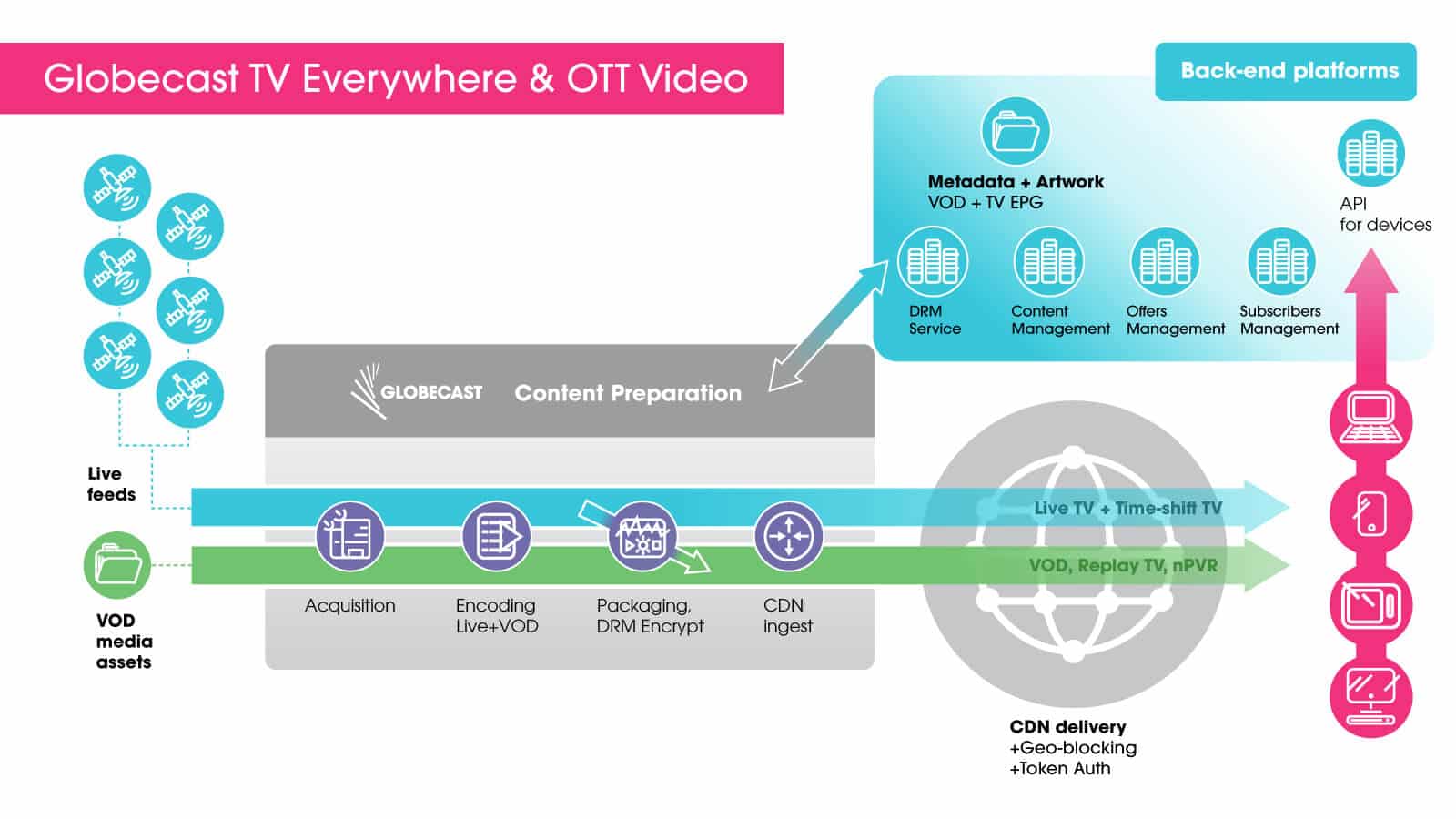A blog post by Frédéric Torasso, Globecast TV Everywhere Product Manager
As OTT Video services have grown in popularity over recent years, many of us are aware that some of the services have experienced major problems. How can these be avoided?
The importance of OTT Video to broadcasters
It is, without exaggeration, crucial for broadcasters to have a comprehensive OTT video strategy, not only for catch-up content, but also for linear channels online – including live content – and in many cases for one-off live events too. As we all know, OTT video consumption is now a requirement for many viewers; indeed, for many it’s the way that they consume content. And of course, when architected correctly, key audience metrics are available to content suppliers in order to create targeted content and services. And because online audiences are growing so fast, advertising spending is shifting from traditional media to digital.
A business model, not a technology

OTT is a business model, not a technology, and it covers a whole host of services. When we say, “OTT Video technology”, we must understand adaptive bitrate streaming (ABR). This is the underlying technology that enables the delivery of OTT media services without any prior agreement with internet service providers to reach their subscribers. Here we are talking about OTT video where content owners, broadcaster and video platforms can go direct-to-consumer, using the public internet to reach their audience.
Technically speaking, video delivery once relied on streaming protocols like Real Media, RTSP and Flash RTMP; now we’ve moved to adaptive bitrate streaming media delivery over HTTP using, for example, HLS or DASH streaming media formats. Moving to HTTP-based delivery removed the need for protocol-specific media delivery infrastructure in the network and allowed HTTP-only CDNs to lower their pricing for scalable video delivery. Media playback on devices also evolved to the point where these ABR streaming formats are natively supported, removing the need for the user to install untrusted plug-ins such as Flash. It has also removed the hated message, and awful user experience: “Please wait while video is buffering!”
What are the key challenges behind a live OTT video service?
The main technical challenges are about ensuring service availability and scalability. The main marketing challenges are audience acquisition, engagement and loyalty: how to get, keep and grow your audience. The main business challenge is understanding changes in media consumption habits for the various audience demographics. You also have to take into account how to monetize services: advertising, subscription or transaction-based.
Avoiding technical issues
The media delivery path runs from the event source to the processing platform then to viewers using a CDN. There’s always the chance that something can go wrong along the chain. But when large audience events are taking place, there should be sufficient redundancy to cover almost all links in that chain – especially for live events. The CDN could struggle to cope with particularly large audiences if its footprint, in terms of Points-of-Presence (PoPs) and bandwidth to interconnect with ISPs, are too limited.
The control plane (or path) links end-user devices to the service platform, where content is declared in a CMS (Content Management System), authorized users are registered, DRM licenses are issued, stream token protection mechanisms are implemented, etc. If the service platform is highly stressed by large audiences, it can fail to cope with the load, especially at the back-end server level that handles user requests/responses. It has happened in the past, even to premium OTT video platforms; for example, when a highly anticipated TV series is released. The best way to handle this kind of stress for such a platform is to design its software for real-time elastic workload adaptability by using public cloud computing platforms and associated APIs (programmatic interfaces) to automatically expand to handle peak periods.
How difficult is it to scale up services to cope with major live events?
If you are using a strong and reliable media CDN service provider, scaling is no issue. We work with top CDN service operators and they have proved multiple times their suitability for large scale OTT live video services with their global ability to scale. Indeed, one of them recently set a record for peak traffic.
But this is only related to media delivery. Some providers’ failure to cope with audience demand have been caused by a back-end platform that was not “elastic” enough to handle peak traffic from device/users. This is where the cloud comes in.
So, what is the role of the cloud?
Using the cloud is the easiest and most cost-effective solution to cope with varying audience demands, thanks to its inherent elasticity. This is mainly useful for back-end platforms that manage connections from/to end-user devices (the front-ends).
Then there’s associated software-defined video platforms. These are not related to audience scalability. The key benefit of this software-defined video approach is the ability to far more easily change and adapt business models to varying market conditions by allowing new channels to be deployed, or the discontinuation of services, with the click of a mouse. This means faster time-to-market, as well as the easy launching of pop-up channels for temporary events. This approach also saves on human resources.
And what about device compatibility?
Thanks to the HTML5 video standard, this is now far less of an issue than it used to be. But a video player – whether it is built into an app or via a browser – is not only about video playback. That’s the easy part.
A modern video player needs to support security features: DRM, tokens, geo-blocking and so on. It also needs to support client-side metrics: content consumption for audience metrics; user journey monitoring; quality of experience reporting; monetization features; various ad formats (display, pre-roll, overlay…); cost-saving and QoE features; viewer-to-viewer peer-assisted media content redistribution. The list goes on.
Thanks to our partner EasyBroadcast, Globecast provides its OTT video customers with all the client-side (front end) modern features to empower their OTT Video business with state-of-the-art web and native mobile apps.
What is Globecast’s TV Everywhere solution?
Globecast TV Everywhere is a fully managed service for linear TV broadcasters wanting to reach their audience online. It combines linear TV signal processing at the video head-head level; CDN delivery to the audience; client-side web video player and native mobile apps for OTT video devices such as smartphones and tablets and also for OTT video set-top-boxes and HDMI sticks. We provide monetization through ads or paid subscriptions. We integrate with customer’s existing back-end platform or suggest a third-party one as recommended by us (see the diagram here).
We have various types of broadcast customers using our services, with different levels of preparation for the digital era, both in their organization and in their people. So, we find that our approach for the less digitally-aware is very much appreciated when it comes to navigating the business and technical journeys.
As we said at the start, providing properly architected OTT video services is now crucial for broadcasters. A dedicated, experienced partner is required to handle this process correctly, with a cost-conscious approach, short time-to-market and proven track record of satisfied customers.


